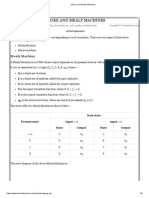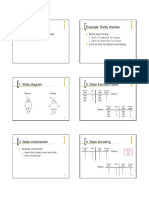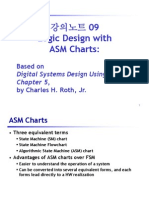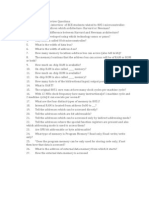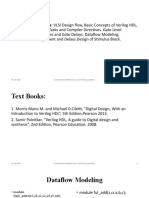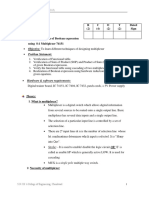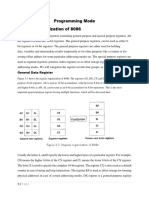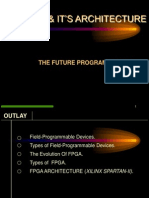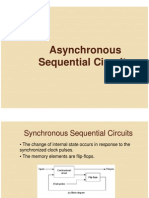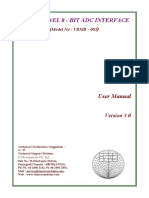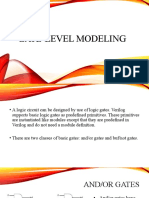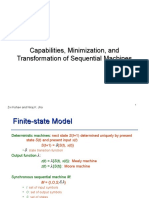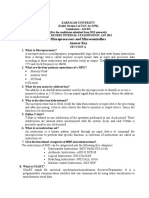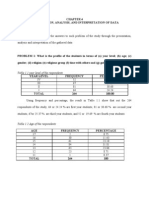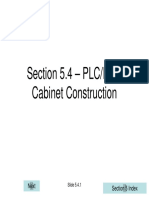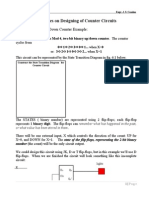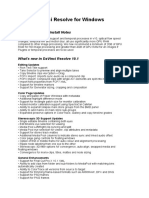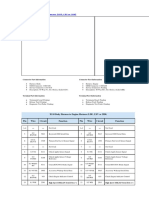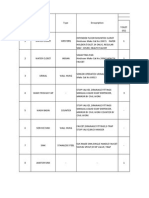CS1103
ASM Charts
Algorithmic State Machine (ASM) Chart is a high-level
flowchart-like notation to specify the hardware
algorithms in digital systems.
Major differences from flowcharts are:
uses 3 types of boxes: state box (similar to operation box),
decision box and conditional box
contains exact (or precise) timing information; flowcharts
impose a relative timing order for the operations.
From the ASM chart it is possible to obtain
the control
the architecture (data processor)
CS1104-14
ASM Charts
�Components of ASM Charts
The state box is rectangular in shape. It has at most
one entry point and one exit point and is used to
specify one or more operations which could be
simultaneously completed in one clock cycle.
state
binary
code
one or more
operations
CS1104-14
Components of ASM Charts
�Components of ASM Charts
The decision box is diamond in shape. It has one
entry point but multiple exit points and is used to
specify a number of alternative paths that can be
followed.
deciding
factors
CS1104-14
deciding
factors
Components of ASM Charts
�Components of ASM Charts
The conditional box is represented by a rectangle with
rounded corners. It always follows a decision box and
contains one or more conditional operations that are
only invoked when the path containing the conditional
box is selected by the decision box.
conditional
operations
CS1104-14
Components of ASM Charts
�ASM Charts: An Example
An example:
T0
Initial state
A is a register; Ai
stands for ith bit of
the A register.
A = A4A3A2A1
T1
E and F are singlebit flip-flops.
A 0
F 0
A A+ 1
A2
E 0
E 1
A3
T2
1
F 1
CS1104-14
ASM Charts: An Example
�Register Operations
Registers are present in the data processor for
storing and processing data. Flip-flops (1-bit
registers) and memories (set of registers) are also
considered as registers.
The register operations are specified in either the
state and/or conditional boxes, and are written in the
form:
destination register function(other registers)
where the LHS contains a destination register (or part of one)
and the RHS is some function over one or more of the
available registers.
CS1104-14
Register Operations
�Register Operations
Examples of register operations:
A B
A 0
A A 1
CS1104-14
Transfer contents of register B into
register A.
Clear register A.
Decrement register A by 1.
Register Operations
�Timing in ASM Charts
Precise timing is implicitly present in ASM charts.
Each state box, together with its immediately
following decision and conditional boxes, occurs
within one clock cycle.
A group of boxes which occur within a single clock
cycle is called an ASM block.
CS1104-14
Timing in ASM Charts
�Timing in ASM Charts
T0
Initial state
1
T1
A 0
F 0
A A+ 1
3 ASM blocks
A2
E 0
E 1
A3
T2
1
F 1
CS1104-14
Timing in ASM Charts
10
�Timing in ASM Charts
Operations of ASM can be illustrated through a
timing diagram.
Two factors which must be considered are
operations in an ASM block occur at the same time in one
clock cycle
decision boxes are dependent on the status of the previous
clock cycle (that is, they do not depend on operations of
current block)
CS1104-14
Timing in ASM Charts
11
�Timing in ASM Charts
clock
10
11
12 13
states
T0
T0
T1
T1
T1
T1
T1
T1
T1
T2
T0
T0
input
S=0
S=1
A=2
A=3
A=4
register
values
Operations
T0
S=0
A=0
F=0
A=1
A=7
F=1
E=0
A0
F0
A=5 A=6
E=0
AA+1
E0
AA+1
E0
E=1
E=1
AA+1
E1
AA+1
E1
E=0
E=0
E=1
AA+1
E0
AA+1
E0
F1
AA+1
E1
A = A4A3A2A1
CS1104-14
Timing in ASM Charts
12
�Timing in ASM Charts
T0
Initial state
clock
states
T0
T0
T1
T1
T1
T1
input
S=0
S=1
A=1
A=2
A=3
E=0
E=0
E=1
register
values
S=0
A=0
F=0
1
T1
A 0
F 0
A0
F0
Operations
A A+ 1
A2
E 0
T2
0
1
F 1
A = A4A3A2A1
CS1104-14
clock
10
11
12 13
states
T1
T1
T1
T2
T0
T0
T0
input
E 1
A3
AA+1
AA+1
E0
E1
AA+1
AA+1
E0
E1
register
values
A=4
A=5 A=6
A=7
E=1
E=0
E=1
F=1
E=0
AA+1
F1
E0
AA+1
AA+1
E0
E1
Operations
Timing in ASM Charts
13
�ASM Chart => Digital System
ASM chart describes a digital system. From ASM
chart, we may obtain:
Controller logic (via State Table/Diagram)
Architecture/Data Processor
Design of controller is determined from the decision
boxes and the required state transitions.
Design requirements of data processor can be
obtained from the operations specified with the state
and conditional boxes.
CS1104-14
ASM Chart => Digital System
14
�ASM Chart => Controller
Procedure:
Step 1: Identify all states and assign suitable codes.
Step 2: Draw state diagram.
Step 3: Formulate state table using
State from state boxes
Inputs from decision boxes
Outputs from operations of state/conditional boxes.
Step 4: Obtain state/output equations and draw circuit.
CS1104-14
ASM Chart => Controller
15
�ASM Chart => Controller
T0
T2
A 0
F 0
Present
state
G1 G0
A A+ 1
A2
E 0
E 1
A3
T2
1
F 1
CS1104-14
T0 = 00
T1 = 01
T2 = 11
T1
1
T1
Assign codes to states:
T0
Initial state
0
0
0
0
0
1
0
0
1
1
1
1
Next
state
inputs
outputs
A2 A3 G1+ G0+ T0 T1 T2
0
1
X
X
X
X
X
X
0
1
1
X
X
X
X
0
1
X
0
0
0
0
1
0
0
1
1
1
1
0
1
1
0
0
0
0
0
0
1
1
1
0
0
0
0
0
0
1
Inputs from conditions in decision boxes.
Outputs = present state of controller.
ASM Chart => Controller
16
�ASM Chart => Architecture/Data
Processor
Architecture is more difficult to design than controller.
Nevertheless, it can be deduced from the ASM chart.
In particular, the operations from the ASM chart
determine:
What registers to use
How they can be connected
What operations to support
How these operations are activated.
Guidelines:
always use high-level units
simplest architecture possible.
CS1104-14
ASM Chart => Architecture/Data
Processor
17
�ASM Chart => Architecture/Data
Processor
Various operations are:
Counter incremented (A A + 1) when state = T1.
Counter cleared (A 0) when state = T0 and S = 1.
E is set (E 1) when state = T1 and A2 = 1.
E is cleared (E 0) when state = T1 and A2 = 0.
F is set (F 1) when state = T2.
Deduce:
One 4-bit register A (e.g.: 4-bit synchronous counter with
clear/increment).
Two flip-flops needed for E and F (e.g.: JK flip-flops).
CS1104-14
ASM Chart => Architecture/Data
Processor
18
�Implementing the Controller
Once the state table is obtained, the controller can
be implemented using one of these techniques.
1. Traditional method: With JK flip-flops.
design done at gate level.
suitable for small controllers.
procedure: prepare state table, use K-maps to obtain next-
state/output functions.
2. Decoder + D flip-flops
suitable for moderately large controllers.
procedure: use decoder to obtain individual states; from the
state table, obtain the next-state functions by inspection.
CS1104-14
Implementing the Controller
19
�Implementing the Controller
3. Multiplexers
a more structured approach to implement controller.
suitable for moderately large controllers.
three level structure:
first level consists of multiplexers that determine the next
state of the register;
second level is a register that holds the present state;
third level has a decoder to provide separate output for each
controller state.
CS1104-14
Implementing the Controller
20
�Implementing the Controller
4. One flip-flop per state
also known as One-Hot Spot Method of ASM synthesis.
procedure: allocate one flip-flop per state; from state table,
determine the formulae to set each flip-flop; must ensure
that controller is properly initialised.
5. PLA/ROM
highly regular approach.
ROM approach uses a very simple table lookup technique
but suffers from large number of dont care states.
PLA can handle dont care states well but design method is
still at gate-level.
CS1104-14
Implementing the Controller
21
�Implementing Controller:
With JK Flip-flops
State table
Present
state
G1 G0
0
0
0
0
0
1
0
1
0
1
1
1
obtained from
ASM chart:
inputs
S
0
1
X
X
X
X
A2
X
X
0
1
1
X
A3
X
X
X
0
1
X
Next
state
G1+ G0+
0
0
0
1
0
1
0
1
1
1
0
0
outputs
T0
1
1
0
0
0
0
T1
0
0
1
1
1
0
T2
0
0
0
0
0
1
Corresponding state table using JK flip-flops:
Present
state
G1 G0
0 0
0 0
0 1
0 1
0 1
1 1
CS1104-14
inputs
S A2
0 X
1 X
X 0
X 1
X 1
X X
Next
state
Flip-flop
inputs
A3 G1+ G0+ JG1 KG1 JG0 KG0
X 0
0
0
X
0
X
X 0
1
0
X
1
X
X 0
1
0
X
X
0
0 0
1
0
X
X
0
1 1
1
1
X
X
0
X 0
0
X
1
X
1
Implementing Controller: With JK
Flip-flops
22
�Implementing Controller:
Decoder + D Flip-flops
The flip-flop input functions can be obtained directly
from the state table by inspection.
This is because for the D flip-flops, the next state =
flip-flop D input.
Decoder is then used to provide signals to represent
different states.
?
G1
D Q
D Q
G0
2x4
decoder
T0
T1
unused
T2
clock
CS1104-14
Implementing Controller: Decoder
+ D Flip-flops
23
�Implementing Controller:
Decoder + D Flip-flops
Given the
state table:
Present
state
G1 G0
0
0
0
0
0
1
0
0
1
1
1
1
Next
state
inputs
outputs
A2 A3 G1+ G0+ T0 T1 T2
0
1
X
X
X
X
X
X
0
1
1
X
X
X
X
0
1
X
0
0
0
0
1
0
0
1
1
1
1
0
1
1
0
0
0
0
0
0
1
1
1
0
0
0
0
0
0
1
We can directly determine the inputs of the D flipflops for G1 and G0.
DG1 = T1.A2.A3
DG0 = T0.S + T1
CS1104-14
Implementing Controller: Decoder
+ D Flip-flops
24
�Implementing Controller:
Decoder + D Flip-flops
Flip-flop input functions:
DG1 = T1.A2.A3
DG0 = T0.S + T1
Circuit:
A2
A3
G1
D Q
D Q
G0
2x4
decoder
T0
T1
unused
T2
clock
CS1104-14
Implementing Controller: Decoder
+ D Flip-flops
25
�Implementing Controller:
One Flip-flop per State
Require n flip-flops for n states; each flip-flop
represents one state. (Other methods: n flip-flops
for up to 2n states.)
?
D Q
T0
D Q
T1
:
:
clock
CS1104-14
Implementing Controller: One
Flip-flop per State
26
�Implementing Controller:
One Flip-flop per State
Formulae for next state can be obtained directly
from state table:
1. If there is only one line going into the state, then
formula = input condition ANDed with the previous
state.
2. If there are more than one line, then formula = Ored of
all the conditions found in (1).
CS1104-14
Implementing Controller: One
Flip-flop per State
27
�Implementing Controller:
One Flip-flop per State
State table:
Present
state
State diagram:
Next
state
inputs
S A2 A3
T0
T0
T1
T1
T1
T2
0
1
X
X
X
X
X
X
0
1
1
X
X
X
X
0
1
X
S=0
A2=0
S=1
T0
T1
T1
T1
T2
T0
T0
T1
T2
A2=1,
A3=0
A2=1,
A3=1
Flip-flop input functions:
DT0 = T2 + S'.T0
DT1 = S.T0 + A2'.T1 + A2.A3'.T1 = S.T0 + (A2.A3)'.T1
DT2 = A2.A3.T1
CS1104-14
Implementing Controller: One
Flip-flop per State
28
�Implementing Controller:
One Flip-flop per State
Circuit diagram below. To initialise to state T0, set
flip-flop of T0 to 1 and clear the rest to zero.
preset
A2
A3
DT0 = T2 + S'.T0
DT1 = S.T0 + (A2.A3)'.T1
DT2 = A2.A3.T1
CS1104-14
D Q
T0
D Q
T1
D Q
T2
clock
clear
Implementing Controller: One
Flip-flop per State
29
�Implementing Controller:
One Flip-flop per State
Alternative: Use Q' output for T0, and input function
for T0 is complemented. To initialise, clear all flipflops to zero.
D Q
Q'
A2
A3
DT0 = (T2 + S'.T0)'
DT1 = S.T0 + (A2.A3)'.T1
DT2 = A2.A3.T1
CS1104-14
T0
D Q
T1
D Q
T2
clock
clear
Implementing Controller: One
Flip-flop per State
30
�Implementing Controller:Multiplexers
Purpose of multiplexer is to produce an input to its
corresponding flip-flop equals to the value of the next
state.
The inputs of multiplexers are determined from the
decision boxes and state transitions in the ASM chart.
CS1104-14
Implementing Controller:
Multiplexers
31
�Implementing Controller:Multiplexers
Example 1: Given
the state table.
Reformat the
state table.
CS1104-14
Present
state
G1 G0
0
0
0
0
0
1
0
1
0
1
1
1
Present
state
inputs
S
0
1
X
X
X
X
Next
state
G1 G0 G1
0 0
0
0 0
0
0 1
0
0 1
0
0 1
1
1 1
0
Next
state
A2 A3 G1+ G0+
X X
0
0
X X
0
1
0 X
0
1
1 0
0
1
1 1
1
1
X X
0
0
G0+
Input
conditions
0
1
1
1
1
0
S'
S
A2'
A2. A3'
A2. A3
1
Implementing Controller:
Multiplexers
Multiplexer
inputs
MUX1
MUX0
?
32
�Implementing Controller:Multiplexers
Obtain multiplexer inputs:
Present
state
Next
state
G1 G0 G1
0 0
0
0 0
0
0 1
0
0 1
0
0 1
1
1 1
0
CS1104-14
G0
0
1
1
1
1
0
Input
conditions
S'
S
A2'
A2. A3'
A2. A3
1
Multiplexer
inputs
MUX1
MUX0
A2. A3
A2' + A2. A3' + A2. A3
=1
Implementing Controller:
Multiplexers
33
�Implementing Controller:Multiplexers
Present
state
Draw circuit:
G1 G0
0 0
0 1
1 1
T0
T1
T2
A2
A3
0
0
0
1 MUX1
2
3
S1 S0
D Q
S1 S0
0
1 MUX0
2
3
D Q
MUX0
S
1
0
G0
T0
T1
T2
clock
Determine next
state of register
CS1104-14
MUX1
0
A2. A3
0
G1
2x4
decoder
S
1
Multiplexer
inputs
Hold present
state
Implementing Controller:
Multiplexers
34
�Implementing Controller:Multiplexers
Present
state
Example 2:
T0
T1
0
T3
0
0
0
w
1 01
11
y
1
CS1104-14
G1 G0 G1
0
0
0
0
0
0
0
1
1
0
1
1
1
0
0
1
0
1
1
0
1
1
1
0
1
1
1
1
1
1
00
T2
1
1
Next
state
Present
state
10
y
0
T0
T1
T2
T3
G0
0
1
0
1
0
0
1
1
0
1
Input
conditions
w'
w
x
x'
y'
y.z'
y.z
y'.z
y
y'.z'
Multiplexer
inputs
G1 G0
MUX1
MUX0
0
0
0
w
0
1
x+x'=1
x'
1
0 y.z' + y.z
y.z
=y
1
1
y + y'.z'
y'.z +
= y + z' y'.z' = y'
Implementing Controller:
Multiplexers
35
�Implementing Controller:Multiplexers
Present
state
T0
T1
T2
T3
y
z'
0
1
y
G1 G0
0 0
0 1
1 0
1 1
Multiplexer
inputs
MUX1
0
1
y
y + z'
0
1 MUX1
2
3
S1 S0
D Q
MUX0
w
x'
y.z
y'
G1
2x4
decoder
y
z
CS1104-14
w
x'
y'
S1 S0
0
1 MUX0
2
3
D Q
G0
T0
T1
T2
T3
clock
Implementing Controller:
Multiplexers
36
�Implementing Controller: PLA/ROM
Similar to the design using D flip-flops and a decoder.
The only difference is PLA essentially replaces the
decoder and all the gates in the inputs of the flipflops.
External
command
PLA/ROM
Present
state
Commands to
architecture
Next
state
Register to represent states
CS1104-14
Implementing Controller:
PLA/ROM
37
�End of segment

